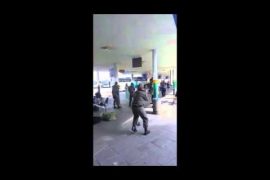1) The ITIC provides analysis on the topic of the rockets recently fired from the Jenin area.
“Since May 2023, six official announcements have been issued regarding rocket attacks from the Jenin region against Israeli communities close to Jenin, mainly Ram-Ohn and the settlement of Shaked; in five instances the rockets were located by the IDF forces. The attacks were carried out by a network in western Jenin calling itself the al-Ayash Battalion. Its logo identifies it as affiliated with the Izz al-Din Qassam Brigades, Hamas’ military-terrorist wing. The network’s claims of responsibility for the rocket launches (one or two at a time) were accompanied by videos published first on Palestinian social networks and later through a dedicated Telegram channel opened by the network. Various posts on the Palestinian social networks represented Jenin as treading the same path as the Gaza Strip, with the hashtag #al-Ayash_Battalion.”
2) At the Moshe Dayan Center, Moran Levanoni discusses ‘The Druze Community in Lebanese Politics’.
“Presently, approximately a quarter of a million Druze reside in Lebanon. They live mainly in the Shuf mountains and Wadi al-Taym at the foot of Mount Hermon. The Druze in Lebanon are few compared with other communities, as they amount to only 3-4% of the Lebanese population. Due to this, senior political positions were not assigned to the Druze, unlike other communities as stipulated in the Lebanese National Pact. Nevertheless, community members have always been involved in critical political developments and have had essential roles in politics, administration, and security. This article will examine the Druze in Lebanese politics and present the prevailing trends within the community.”
3) The Alma Center reports on ‘The Weapons Development Industry in Syria (CERS)’.
“The Syrian regime defines CERS as one of the most sensitive security bodies, if not the most sensitive. Since its foundation, the regime has maintained a high level of security monitoring over the CERS Center’s operations and employees. Since the onset of the civil war and the turning of the CERS Center into a kind of joint Syrian-Iranian-Hezbollah platform, security monitoring has been intensified by the Quds Force and Hezbollah’s security unit in Syria, Unit 9000. The Iranians’ involvement grew and extended in all of the CERS Center’s missions until it took control and monitored everything that transpired there. Certain initiatives, particularly those at Institute 4000 (Sector 4), are currently under direct Iranian supervision by senior IRGC Quds Force officers.”
4) At the FDD, David May and Melissa Sacks discuss the links between European NGOs and terror financing.
“Amin Abou Rashed, president of the European Palestinians Conference (EPC), was rubbing elbows with Swedish politicians at an EPC event in late May. A month later, Rashed and his daughter were reportedly behind bars in the Netherlands for funneling €5.5 million to Hamas. This is just the latest instance of Hamas and other terrorist groups operating under the guise of charities and non-governmental organizations. […]
Speeches by Hamas leader Ismail Haniyeh have been a fan favorite at the EPC, launched by the London-based Palestinian Return Centre (PRC) in 2003. Israel declared the PRC a front for Hamas in 2010.”




